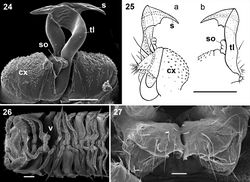Ammodesmidae
| Notice: | This page is derived from the original publication listed below, whose author(s) should always be credited. Further contributors may edit and improve the content of this page and, consequently, need to be credited as well (see page history). Any assessment of factual correctness requires a careful review of the original article as well as of subsequent contributions.
If you are uncertain whether your planned contribution is correct or not, we suggest that you use the associated discussion page instead of editing the page directly. This page should be cited as follows (rationale):
Citation formats to copy and paste
BibTeX: @article{VandenSpiegel2012ZooKeys221, RIS/ Endnote: TY - JOUR Wikipedia/ Citizendium: <ref name="VandenSpiegel2012ZooKeys221">{{Citation See also the citation download page at the journal. |
Ordo: Polydesmida
Familia: Ammodesmidae
Name
VandenSpiegel & Golovatch, 2012 – Wikispecies link – Pensoft Profile
Emended diagnosis
An oligotypic family of minute polydesmidans (1.4–5.0 mm long) with 18 or 19 body segments in both sexes, capable of rolling into a tight sphere. Conglobation pattern becoming typical from paratergum 4 onwards (Golovatch 2003[1]). Animals usually easily recognizable by having paraterga 2 strongly enlarged, all postcollum metaterga being clothed with a cerategument (= cuticular secretion layer) and various tuberculations (sometimes better developed in the male than in the female). Head broader than long. Antennae short, strongly clavate; antennomere 5 longest and largest, distinctly enlarged, about as high as long. Collum small, at best only slightly covering the head from above, only moderately convex. Generally, dorsum highly convex; paraterga very strongly declined ventrad, often deeply incised caudally at base; ventral edge rounded, either not or extremely poorly lobulated, well projecting below venter/coxae. Telson small, fully exposed in dorsal view. Ozopore formula nearly normal, only slightly varying from 5, 7, 9, 10, 12, 13, 15–17(18) (Ammodesmus) to 5, 7, 9, 12, 15–17(18) (Elassystremma); ozopores opening flush on tergal surface at about anterior third of paraterga, this opening sometimes being concealed by preceding paratergum.
Sterna very narrow, coxae usually subcontiguous medially. Last male legs either modified (Ammodesmus) or not (Elassystremma). Gonopod aperture rather modest in size, transversely oval, not reaching sides of metazona ventrally.
Gonopods mostly complex; coxae globose, usually but not always strongly enlarged and deeply excavate in the middle (= gonocoel), cannulae very evident. Telopodites basically unipartite, slender or stout, sometimes with a small lateroparabasal outgrowth, only seldom strongly exposed (Ammodesmus granum), more usually deeply sunken into gonocoel, leaving only tips exposed. Seminal groove mostly running on mesal face, turning laterad due to telopodite twisting only distally to subapically, with a very evident (Ammodesmus granum) or small solenomere either devoid of or supplied with a hairy pulvillus; accessory seminal chamber absent.
Distribution
Liberia, Guinea and Ivory Coast (western Africa), as well as Tanzania, Kenya and Malawi (the African eastern Arc Mountains).
Key to recognized genera of Ammodesmidae
Taxon Treatment
- VandenSpiegel, D; Golovatch, S; 2012: The millipede family Ammodesmidae (Diplopoda, Polydesmida) in western Africa ZooKeys, 221: 1-17. doi
Other References
- ↑ Golovatch S (2003) A review of the volvatory Polydesmida, with special reference to the patterns of volvation (Diplopoda). African Invertebrates 44 (1): 39-60.
Images
|
